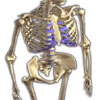Use of nitrates may increase bone strength
Preliminary research indicates that use of nitroglycerin ointment among postmenopausal women for 2 years was associated with a modest increase in bone mineral density and decrease in bone resorption (loss), according to a study in the 23 February issue of JAMA.
“The number of osteoporotic fractures is increasing worldwide as populations age. An inexpensive and widely available treatment may help limit this increase,” the authors write. “Nitroglycerin stimulates bone formation and inhibits bone resorption, is inexpensive, and is widely available. Its effects on bone density, bone structure, and bone strength are unknown.” Nitroglycerin is used medically as a vasodilator (a drug that causes dilation of blood vessels) to treat heart conditions, such as angina and chronic heart failure.
Sophie A. Jamal, MD, PhD, of the Women’s College Research Institute and University of Toronto, Canada, and colleagues tested the efficacy of once-daily nitroglycerin ointment to increase bone mineral density (BMD) at the lumbar spine, femoral (bone in the leg that extends from the hip to the knee) neck and hip. The placebo-controlled randomised trial was conducted from November 2005 to March 2010 and included 243 postmenopausal women. The participants were randomised to nitroglycerin ointment (15 mg/d; n = 126) or placebo (n = 117), applied at bedtime to the upper arm for 2 years.
The researchers found that compared with placebo, women randomised to the nitroglycerin group had significant increases in areal (an area) BMD at the lumbar spine (6.7 per cent), total hip (6.2 per cent), and femoral neck (7.0 per cent) at 24 months. Nitroglycerin users also had increases in certain measures of BMD and bone strength of the radius and tibia. Additionally, compared with placebo, treatment with nitroglycerin was significantly associated with an increase in bone-specific alkaline phosphatase, a marker of bone formation; and a decrease in urine N-telopeptide, a marker of bone resorption.
Incidence of serious adverse events did not differ between the 2 groups. Among those women who continued treatment for 24 months, headaches were reported by 40 (35 per cent) in nitroglycerin and 6 (5.4 per cent) in placebo groups during the first month, decreasing substantially after 12 months.
“In conclusion, daily administration of nitroglycerin ointment increases bone formation and decreases bone resorption; thereby, substantially improving BMD, bone structure, and indices of bone strength at least as much as existing treatments. Together, these findings suggest that daily nitroglycerin may reduce the risk of vertebral and non-vertebral fractures. Furthermore, nitrates have a potential advantage of easy administration as an ointment, patch, or pill and wide availability of generic preparations. The efficacy of nitrates for reducing risk of fracture should be tested in a larger randomised controlled trial,” the authors conclude.
(Source: JAMA/Archives: JAMA)
More information
 | For more information on osteoporosis, including its effect on bones and the importance of nutrition and dairy, as well as some useful videos and tools, see Osteoporosis. |
Dates
Created by:

 Login
Login














